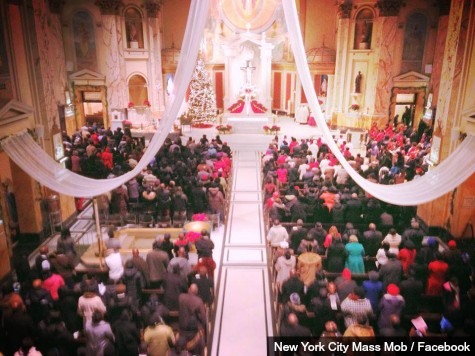On Feb. 1, the Associated Press ran a piece on the Buffalo Mass Mob, led by organizer and founder Christopher Byrd, which uses Facebook and Twitter to assemble like-minded lay Catholics and vote on which of a selection of the city’s under-attended but beautiful historic churches they’re going to attend Mass at on a given weekend.
The story got picked up in print, on television, and on the Web – including by Breitbart, which did a Q&A with Byrd a few days later, and even by a site in Denmark – and began to spread. Then the idea itself took root in other cities.
On Sunday, March 23, Cleveland’s first-ever Mass Mob congregated at St. Casimir Church, with an estimated 500 additional worshipers showing up for the 11 a.m. Mass.
Mass Mob Philly is also underway, with an extra 400 Mass-goers showing up on March 23 at St. Francis Xavier Church, in the city’s Fairmount neighborhood.
It even got the approval of the city’s Archbishop Charles J. Chaput, who said on Facebook, “I’m letting you know about an exciting evangelization initiative making its area debut in our Archdiocese this spring. Borrowed from the idea of flash mobs and modeled after a successful grassroots program developed in the Diocese of Buffalo, a ‘Mass Mob’ encourages Catholics to come together in an organized fashion and in large numbers to attend Mass at a designated parish.”
Mass Mob Greater New Orleans has also just launched on Facebook, along with New York City Mass Mob.
The 23rd was also the Sunday for Buffalo Mass Mob’s third gathering, at St. John Kanty Church, named for a Polish saint. Soon, candidates will be named for the next church on the list, with voting to commence online.
What about the City of the Angels? The Los Angeles Archdiocese is not only the largest in the United States, it’s also one of the oldest. The city’s Catholic heritage stretches back to the late 1700s and early 1800s, with the arrival of Franciscan missionaries from Spain led by Father Junipero Serra. The Church of Our Lady Queen of the Angels (La Iglesia de Nuestra Senora la Reina de Los Angeles) was founded in 1814 by Franciscan Fray Luis Gil y Taboada, and there is a church there to this day.
So far, nothing seems to be brewing in the Southland, but it’s not like there aren’t some gorgeous churches in the area. Perhaps Los Angeles Archdiocese Catholics might want to tear themselves away from the bland utilitarianism of a lot of post-Vatican II suburban churches and visit some of the historic churches of their city (and no, not talking about the Cathedral of Our Lady of the Angels, a k a the “Taj Mahony”).
Here are a few suggestions:
St. Brendan: Built in 1927, the Gothic Revival-style church, with its lavishly decorated vaulted ceiling and huge, brilliantly colored stained-glass windows, is located in the tony Hancock Park neighborhood, adjacent to Hollywood, and has been featured in such movies as Fight Club, Our Gang, War of the Worlds (1953), Armageddon, and Spider-Man 3.
St. Timothy: Located on Pico Boulevard, not far from 20th Century Fox Studios on the Westside of Los Angeles, this Spanish Renaissance church was built in 1943 (replacing the ice-cream parlor that served as the parish’s first worship location). It features an antique gold-leaf 23-foot altarpiece believed to have been created in Spain in the 17th century. There are also a couple of statues – one of the Virgin Mary and one of St. Joseph – acquired from Fox, which used them in the 1946 movie The Jolson Story. Many of the stained-glass windows were created in Ireland (and Celtic crosses can be seen on the exterior).
St. Dominic: Located in the Eagle Rock area of eastern Los Angeles, this little jewelbox of a church is the second home for the parish and was completed in 1941. Although the exterior is whitewashed and fairly plain, like a traditional California mission church, the interior has plenty of ornate touches in the Spanish style. It’s also been used for filming.
St. Andrew: Located in the oldest parish in Pasadena (established in 1886), and one of the oldest altogether in Los Angeles County, the current church was built in 1927 and features a soaring Romanesque Revival campanile bell tower that visible for miles. The interior is modeled after the Basilica of St. Sabina in Rome and is in the Byzantine style, with stunning and colorful murals (some of which were displayed first in Italy), a white Carrara marble altar and multicolored marble pillars. There’s even a book about it.

COMMENTS
Please let us know if you're having issues with commenting.